
This tour begins at the north-east corner of the park, the closest point to the dormitory…
MO#2A
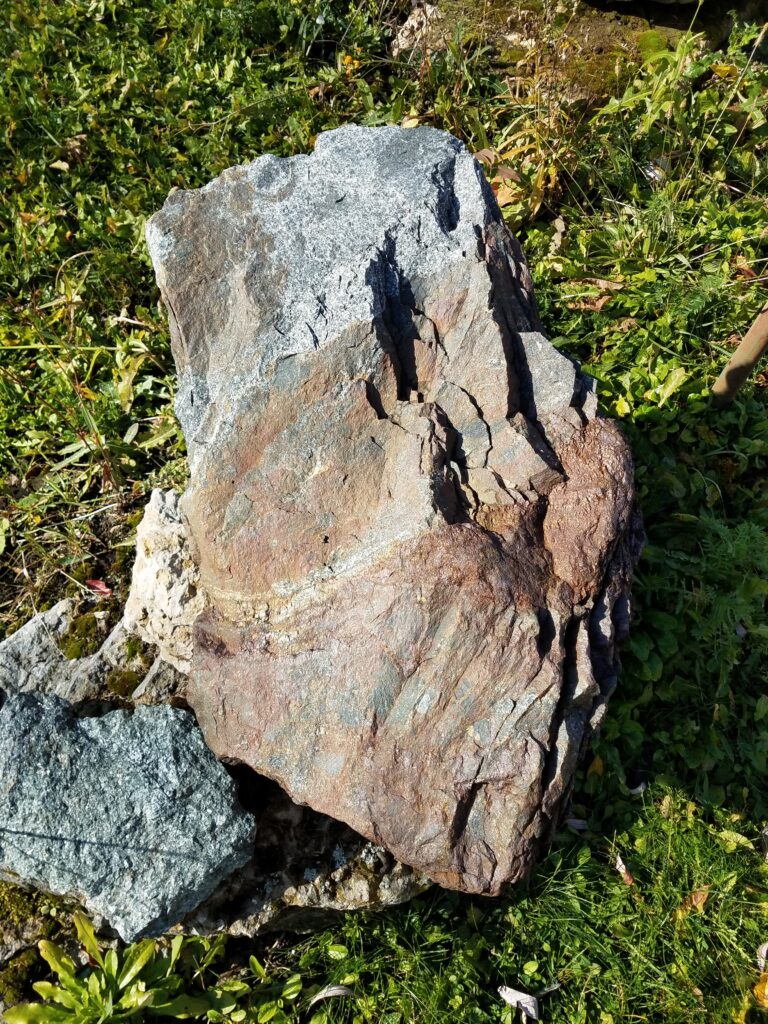
This exhibit is from the Sudbury area, specifically the Coleman Mine. It was brought up from 4055 feet below ground level. Locally known as the North Range of the Sudbury Basin, the deposit was created by a meteor impact about 1.85 billion years ago. This exhibit shows contact between Granitic and Mafic breccia’s, and the sulphides that are averaging 2.26% nickle and 1.19% copper, + precious metals at 0.043 oz/ton. Pyrrhotite, Chalcopyrite, and Pentlandite vary as disseminated to concentrated massive sulphides. Late Archean granitic gneiss is the host rock, consisting of granophyres, norites, and quartz gabbros.
Signage sponsored by: Laframboise Drilling Inc. (Earlton, Ontario).
Internet article on Rock Mechanics at Coleman Mine – seek: Difficult Mining Conditions in 153 Orebody at 4550 feet…Z. Hosseini
Internet Virtual Geotour…seek: MNDM Copper Cliff GeoTour
MO#2B
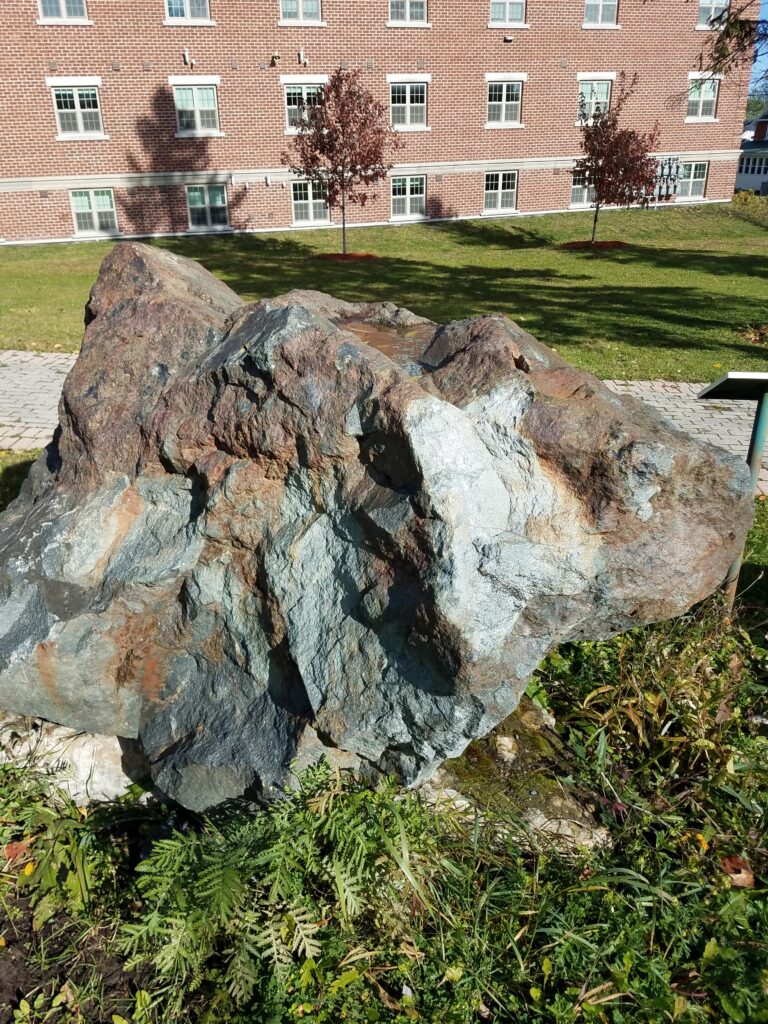
This ore consists of various sulphide minerals such as pentlandite (nickel)[brown to bronze in colour], pyrrhotite (mainly iron, but can contain nickel)[bronze-coloured and somewhat magnetic], and chalcopyrite (copper)[yellow-coloured]. The sample comes from the ‘Gertrude’ open pit of INCO in the Sudbury region, and is one of the original deposits discovered. The rock material is essentially gabbro forming inclusions within the sulphide matrix. Note that this type of ore can contain PGE (Platinum Group Elements). As mentioned for previous samples, this one has been coated, in an attempt to reduce the amount of natural weathering, which would eventually disintegrate the sulphides. For those of you able to access the (former) Haileybury School of Mines building, compare this sample with the large sample of nickel ore from the Clarabelle Mine open pit in the Northern College foyer.
Signage sponsored by Caldwell Construction (New Liskeard, Ontario)
Internet reference on mine names: Ontario Ghost Towns – Gertrude Mine
Internet Geotour…seek: MNDM Discovery Site of Sudbury Mining Camp
MO#3A-1
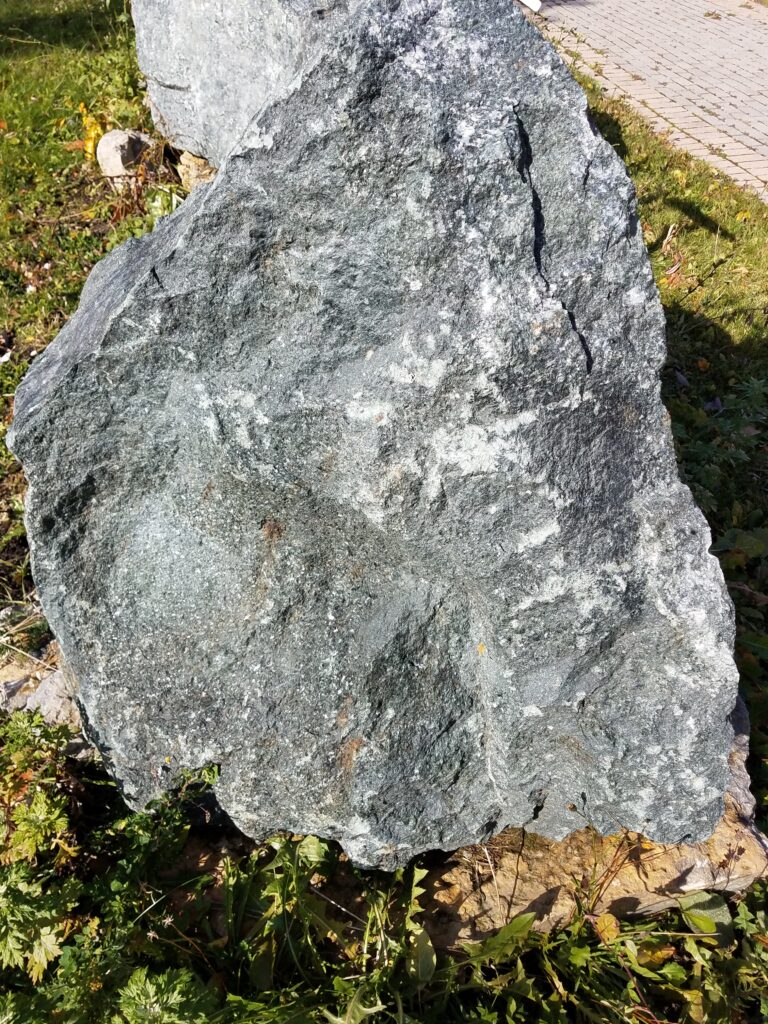
This sample is from the Lac des Iles deposit north of Thunder Bay, Ontario. It represents the PGEor platinum/palladium mineralisation that has been extracted from three different distinct parts of the deposit (this one is labelled the South ‘B’ or “South Intrusive Complex” sample). The host rock is part of an ultramafic intrusion, meaning that it is very rich in iron and magnesium, which in turn makes it dark in colour, and ‘heavy’ in weight.
Internet PGE (Platinum Group Elements) explained…seek: List of Platinum Group Metals or PGM’s
MO#3A-2
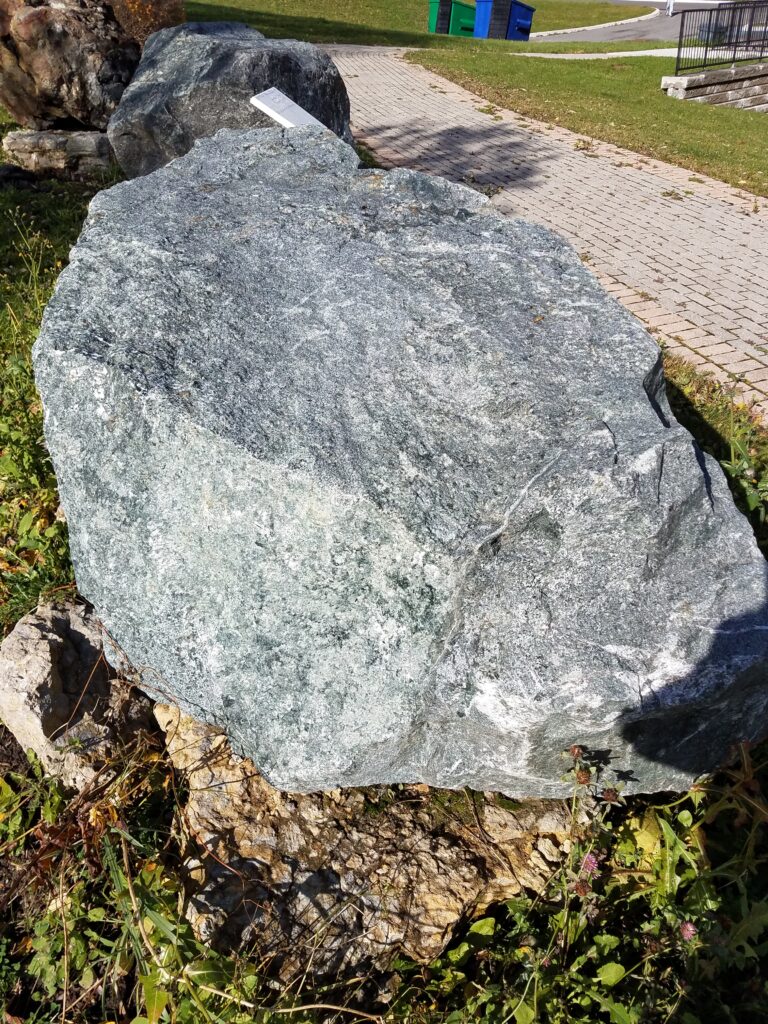
This sample is from the Centre ‘G’ deposit at Lac des Iles, north of Thunder Bay, Ontario. As in the previous sample, the Palladium is too minute to be seen with the naked eye.. On average, “sulphide mineralization” is 50% pyrrhotite, 25% pentlandite, and 25% chalcopyrite.
Internet Virtual Geotour…seek: MNDM Thunder Bay GeoTour
To continue, walk up the path branching off to the left, away from the dormitory and toward the main group of samples set up to the south.
MO#3B
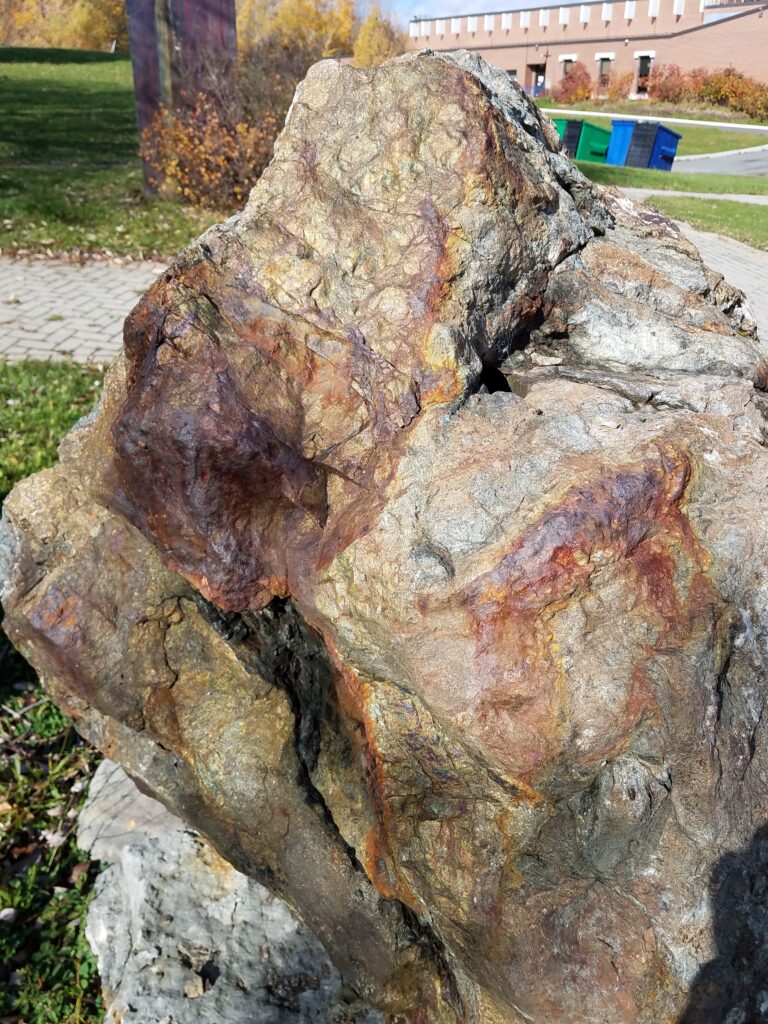
Here is another sample of ultramafic rock, the typical host rock for copper-nickel, platinum group elements (PGE), or even asbestos mineralisation. This sample comes from the Kanichee deposit (an open pit from the 1970’s) north of Temagami, and the copper-nickel (Cu-Ni)(with minor gold and silver), and platinum group elements (PGE) mineralisation is so weathered that the iron content is heavily stained to form a gossan.
Internet photo record see: Kanichee Mine Temagami – Ontario Abandoned
MO#4A
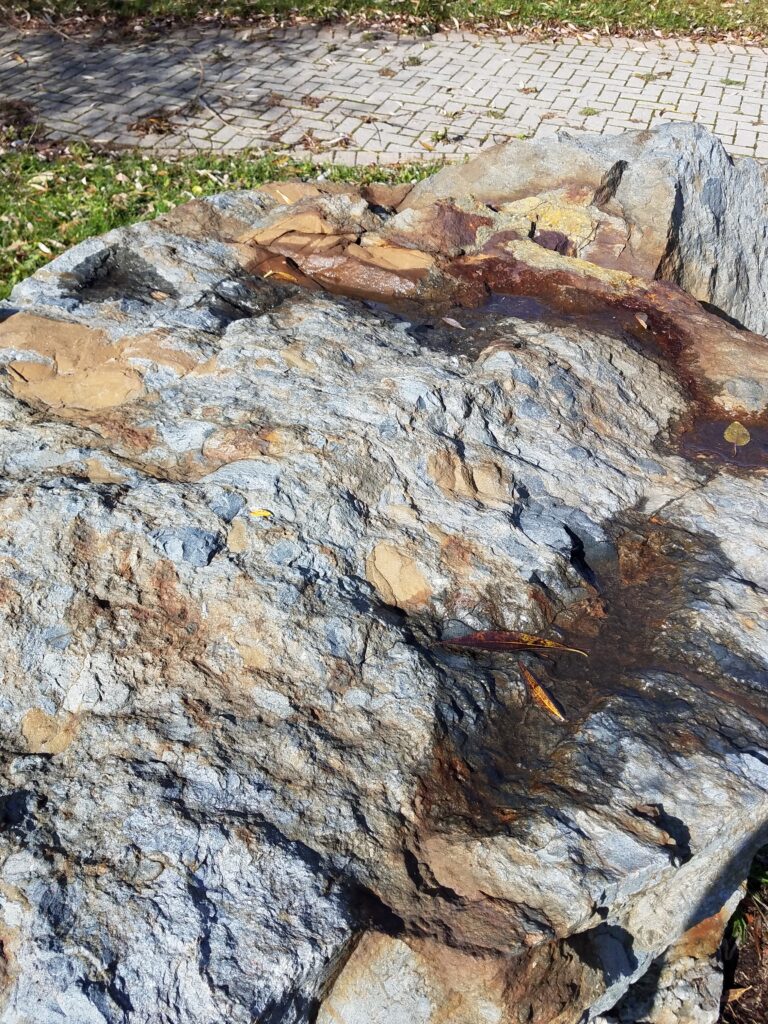
The Kidd Creek deposit north of Timmins, Ontario is known to be one of the ‘elephant’ massive sulphide deposits of the world. By 2020, the deposit had been mined to 3100 meters…the deepest, accessible, non-marine point on earth. The mine has the oldest known flowing water on Earth. A billion-year-old water sample has been identified.
The orebody consists primarily of copper and zinc sulphides (+ silver and indium) within a volcanic complex of rocks ranging from andesite/basalt to rhyolite in composition. The discovery of this deposit in 1963 is one of the famous stories of Canadian mining, especially since the ore lay beneath an extensive cover of overburden. There were two principal rock outcrops close by, and the one on the east side of the eventual open pit could be characterized as a “Geological Indicator”.
Don Sangster of the Geological Survey of Canada coined the term “Mill Rock” to describe this unique volcanic agglomerate occurring so close to the ore that “one could already hear the mill running”! In this sample, the fragments within this rock are particularly suggestive of being close to a possible ore body. Again, for those with access to the Northern College foyer, compare this sample with the large sample of copper-zinc ore from the Kidd Creek deposit set up in there.
Signage sponsored by Lake Shore Gold Corp, Timmins, Ontario
View Kidd’s internet future…Seek: Kidd Creek Encouraging Signs Point
MO#4B
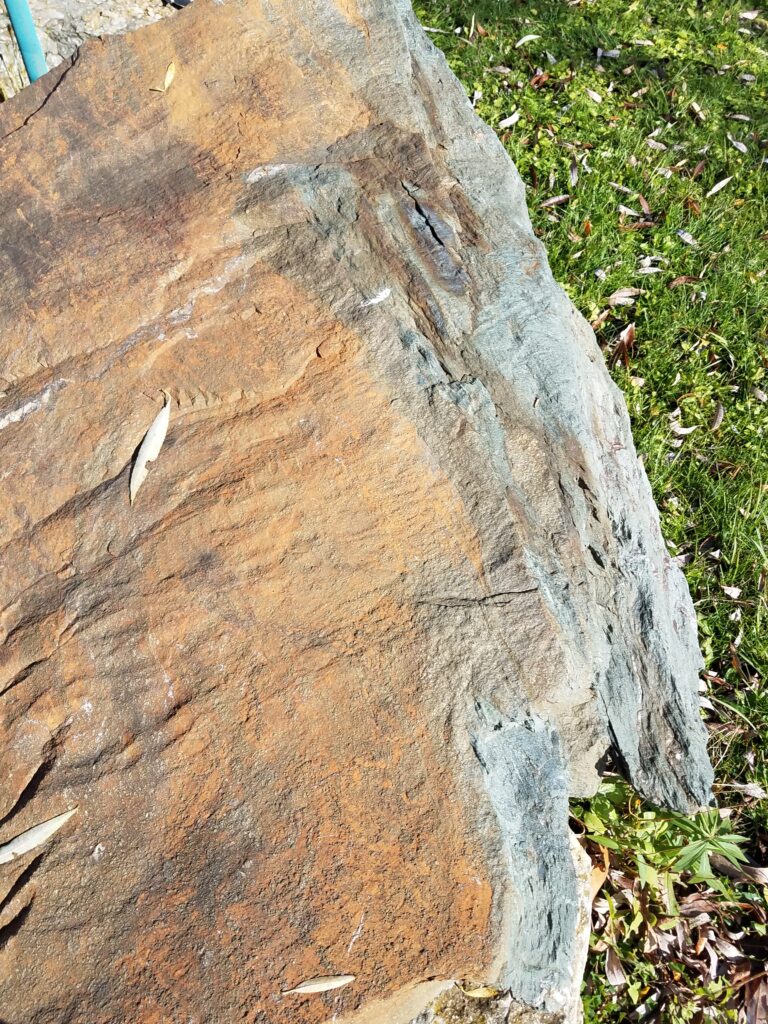
This sample represents mafic metavolcanic massive sulphide from the KamKotia deposit west of Timmins. Found in 1910, it was not developed until it was deemed essential by the WWII Federal “War Minerals” program to provide copper, zinc, gold and silver. The ‘ore’ was encased in massive pyrite. The mine workings were in both pits and underground, between 1943 and 1974. Abandoned, the site generated “Acid Mine Drainage” and became Ontario’s “worst environmental disaster”. For a view of the acid potential of the mine wastes, visit exhibit PGS#4.
Signage sponsored by Stratum (mining) Group, Timmins, Ontario
For additional Internet information visit:
1. https://miningwatch.ca/blog/2006/3/25/kam-kotia
2. The Rehabilitation of the Kam Kotia Mine (Hamblin)
MO#4C
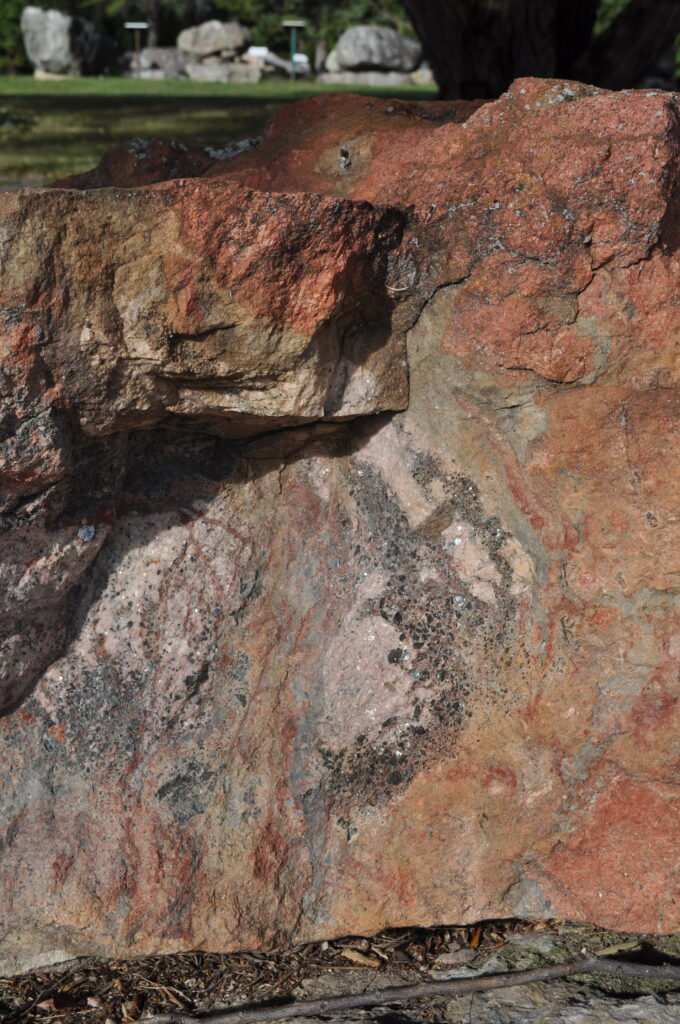
Niobium was discovered in 1967 near Saint-Honore in the Saguenay region of Quebec by SOQUEM, a subsidiary of Provincially funded Investissement Quebec. A partnership with Teck Corp brought the mine and mill into production in 1976. Niobium is an alloy agent that gives unique properties of strength and lightness to steel and other metallic building materials used in construction, aerospace, petrochemicals and automotive industries. It is also used in human orthopedics. It is the only North American source of supply, providing up to 9% of the global requirement. The element is extracted from Pyrochlore that occurs in pegmatites. The ore often contains low levels of naturally occurring radioactive properties. The Quebec deposit is the third largest in the world.
For additional information and pictures visit: https://niobec.com/en/
MO#4E
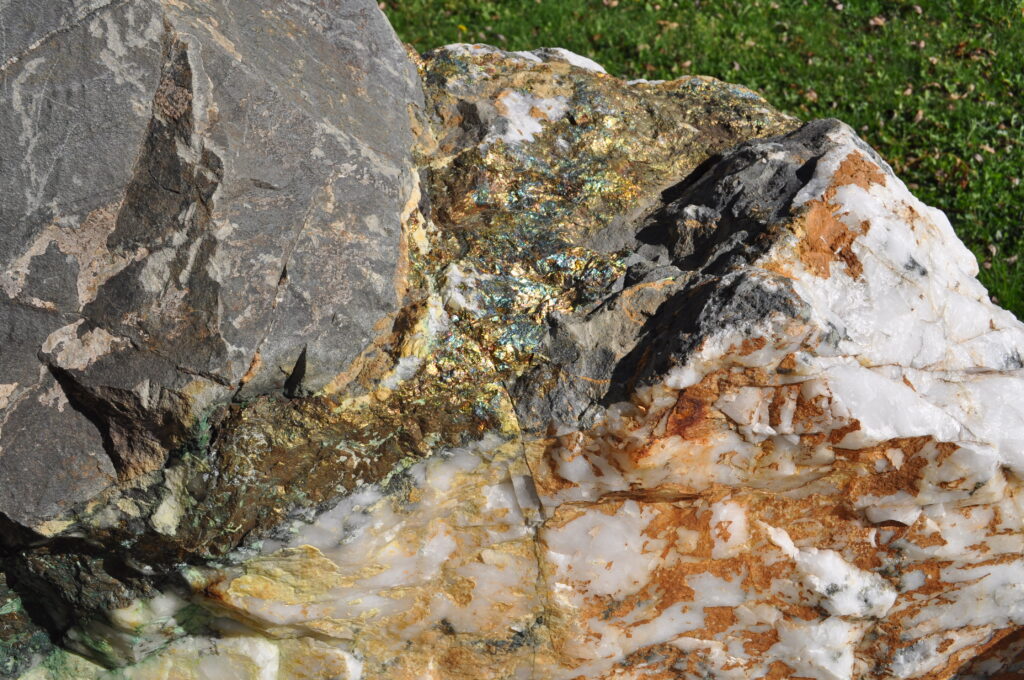
This exhibit is from the Teck Corporation ‘Copperfields’ deposit on Temagami Island in Lake Temagami. Its discovery was unique as it was discovered in a trial of a WWII submarine aeromagnetic tracking device, redeveloped to locate mineral deposits. It was flown over the Temagami area only because the device operator was familiar with the landscape, having a cottage in the area. That operator was Dr. Norman B. Keevil, who was credited with the discovery and staked the mine in 1947. At 28% copper, this was the purist form of chalcopyrite ever found in Canada. The Copperfields (Temagami) Mine operated two shallow open pits and a 2516 foot (762m) shaft from 1955 to 1972. It produced almost 77 million pounds of copper, 176,000 oz. silver, and 125 oz. gold, in a 200 ton per day mill. Note the placement of the mineralization in the exhibit.
Display Sponsor: Autumn A.Gambles, 2006 Alumnus, Northern College, Haileybury Campus.
Internet View: https://www.mininghalloffame.ca/norman-bell-keevil
MO#4F
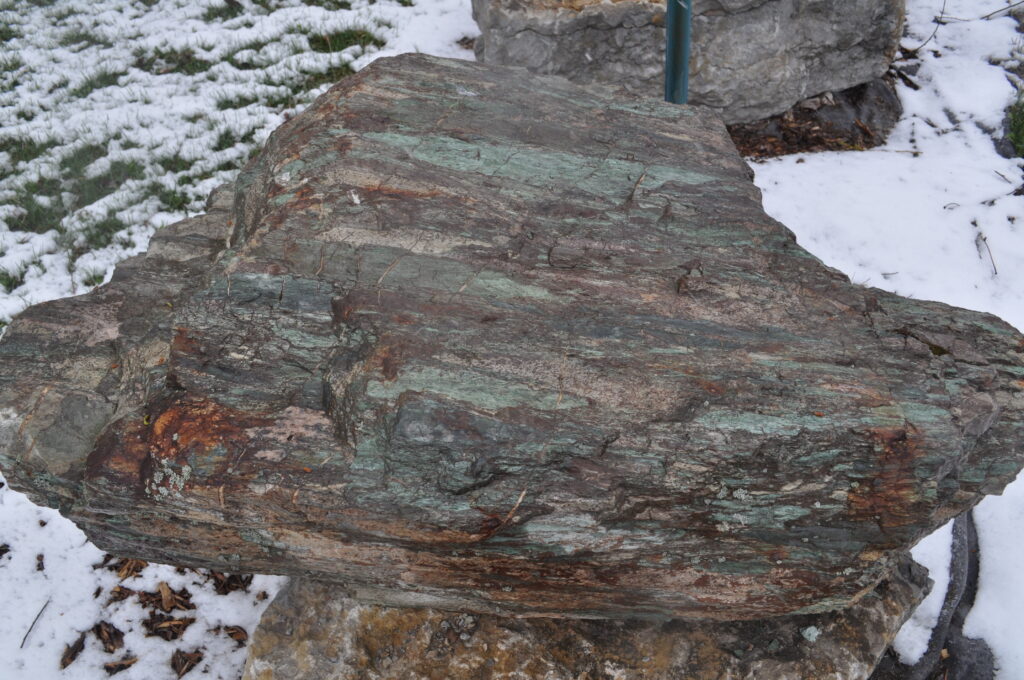
This sample is from a small anomalous copper showing near Matachewan. Government geological records describe the presence of such showings, but copper is not directly associated with the gold deposits of the area.
For internet information, visit: R051:Geology Ontario Matachewan Area
MO#5A
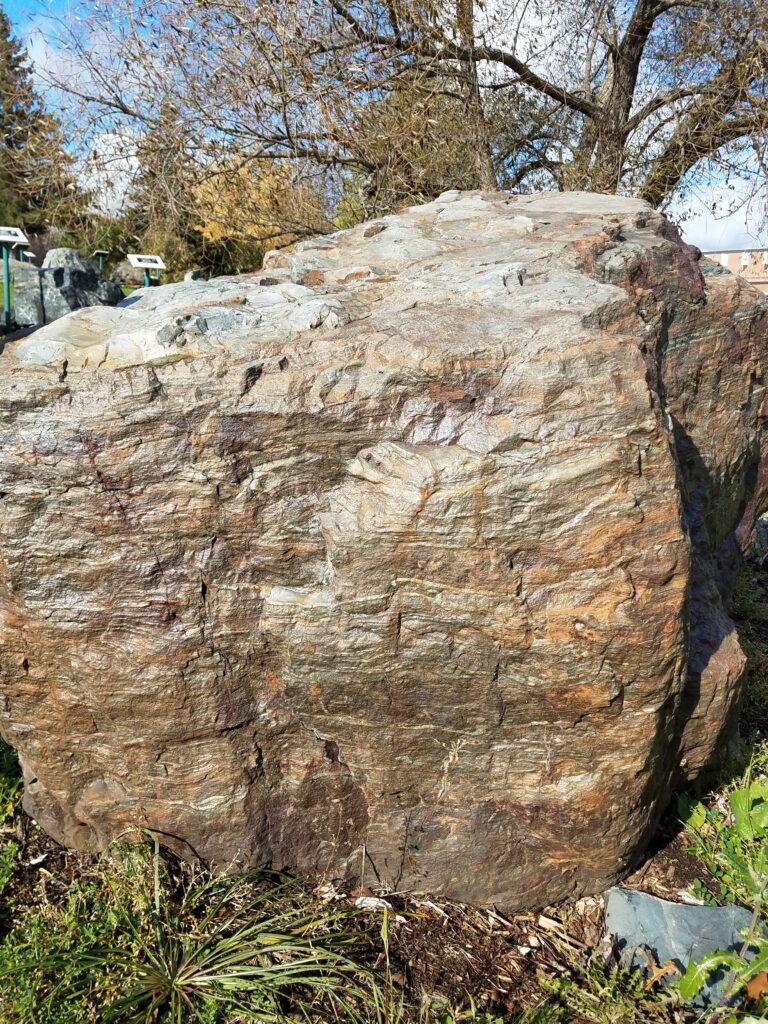
Another ‘elephant’ world-class mineral deposit was the Sullivan mine of Cominco at Kimberley, British Columbia. Discovered in 1892, it operated from 1909 until 2001. RockWalk Park was very fortunate to obtain this sample from the deepest depths of the mine, as the mine closed soon after. The ore consists of layered galena (lead sulphide – bright silver to black) and sphalerite (zinc sulphide – generally brown to yellowish in colour) plus silver and tin. The ore body is known as a “sedimentary exhalative” in nature, with dolostone and other carbonates. It was formed by the release of mineral bearing hydrothermal fluids into a rift basin, where sulphur from marine brines was heated by a thermal anomaly below. This resulted in layering that can still be observed. The sample is coated with a chemical substance to reduce oxidation of the sulphide minerals.
Signage Sponsored by Laframboise Drilling Inc. (Earlton, Ontario).
Internet article on Kimberly view: Sullivan Mine Closure and Reclamation
MO#5B
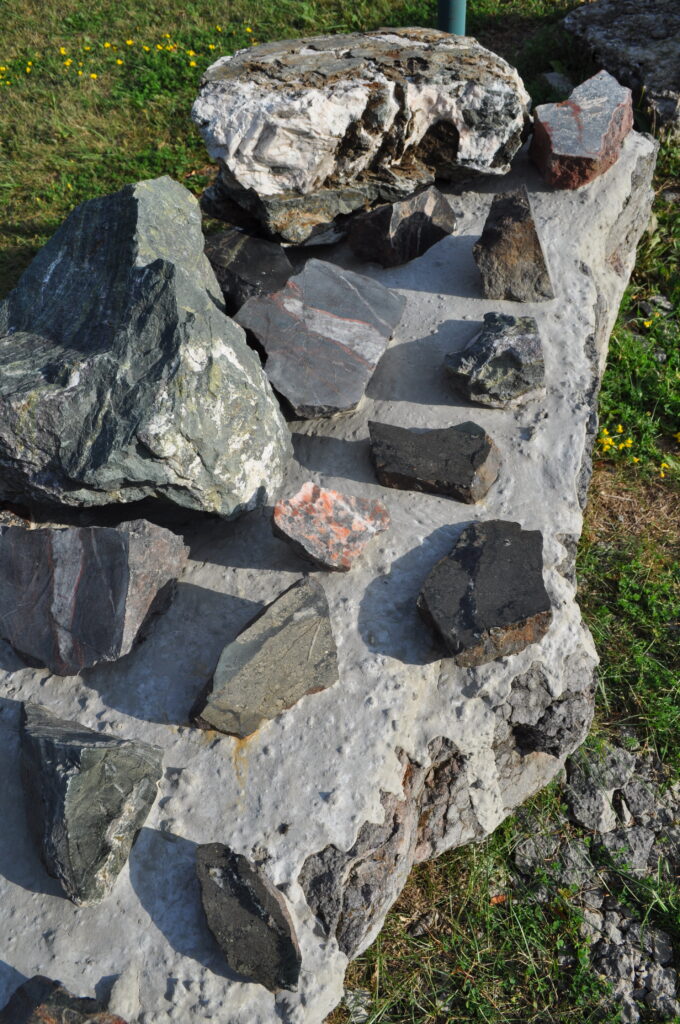
The Upper Beaver Mine, located near Dobie, Ontario was developed in 1913 and produced intermittently under many companies, producing Gold, Silver, and primarily Copper. Mineralization occurs in a host rock of bedded cherty tuff, within veins of massive sulphides (pyrite, chalcopyrite, magnetite, quartz and calcite). Metre wide ore veins of quartz-carbonate were also mined (including chalcopyrite, pyrite, molybdenite, and visible gold). Ore was trucked to the Upper Canada mill at Dobie. The shoreline site is located just downstream of a photogenic rapids on the Misema River, on the traditional lands of the Beaverhouse First Nation people. There is potential for future mine development a short distance to the north of the former mine shaft site. The samples in this exhibit were rescued in 2015 from the remaining waste rock material, mined in 1972. Most of this hand size material was cut and polished, then varnished and cemented together to produce a unique display.
Internet short story: Graveyard Shift: The Last Gold Mine by Marian Botsford Fraser. Exhibit dedicated to J.H.Botsford, Mine Manager (Upper Beaver and Upper Canada) by daughters Marian and Sara.
MO#5C
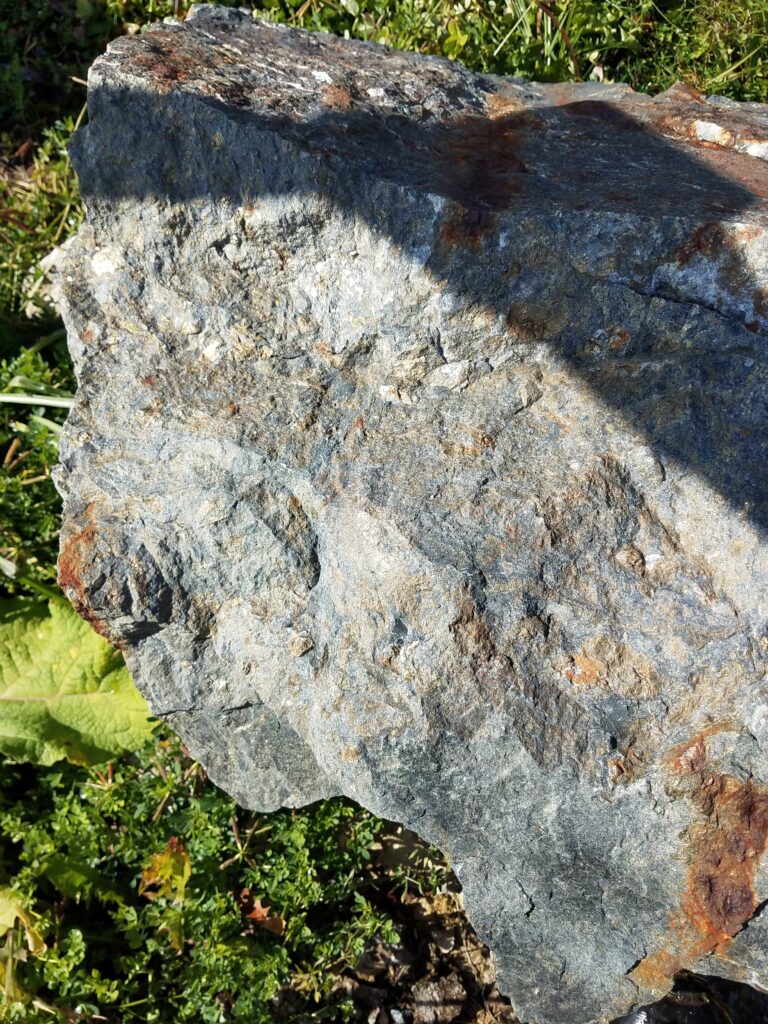
This is a sample showing Marcasite, from the Brady Lake area just south of Cobalt. Marcasite has the same chemical formula as pyrite, but a different crystal structure and commonly a paler yellow colour. Where crystals are well formed, one can see habits ranging from structures looking like the teeth on a gear wheel to cockscomb or spear-shaped. Less well-formed crystals may appear stalactitic, reniform (kidney-shaped) or globular. (Pyrite only appears as cubic crystals.) As an ore indicator, it is most commonly found in carbonate sedimentary rocks that can be host to massive lead-zinc ores.
Signage sponsored by Wayne’s Corner Garage (Cobalt, Ontario)
View on the internet at: https://geology.com/minerals/marcasite.shtml
MO#6A
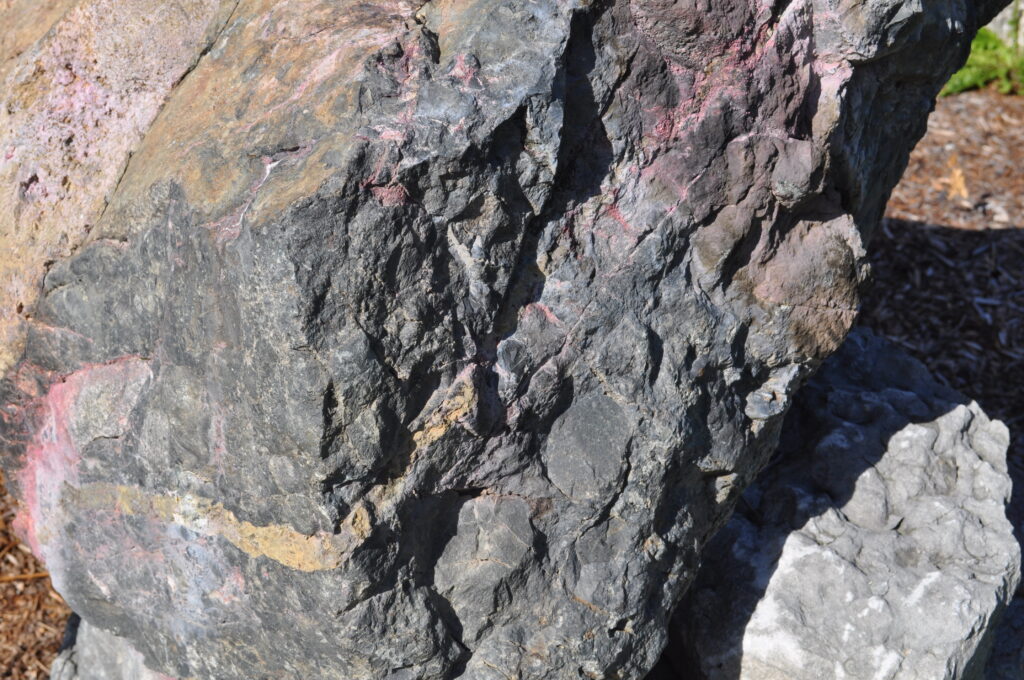
The Cobalt region of northeastern Ontario was once the premier silver mining area of the world. The silver occurred as native silver or part of a complex assemblage of cobalt-iron-nickel arsenide minerals, all within narrow veins of calcite. If a prospector was fortunate enough to trip over silver sheets or plates, the deposit was found; however, discoveries usually required careful study of the rocks, the geological structure, and the alteration. One famous alteration was ‘Cobalt Bloom’ occurring as a red to pinkish stain on samples rich in cobalt, and this ‘bloom’ was often used as a guide to locating veins that just might contain silver. This sample is a piece of ‘float’, left behind by the last continental ice sheet, and the display tries to re-create something of how it would have looked to the original prospector. If you have the opportunity, there is an excellent sample of rich silver ore from the Silverfields deposit at Cobalt available for viewing in the main foyer of the Northern College central building.
Internet virtual tour: MNDM Heritage Silver Trail, Cobalt
MO#6B
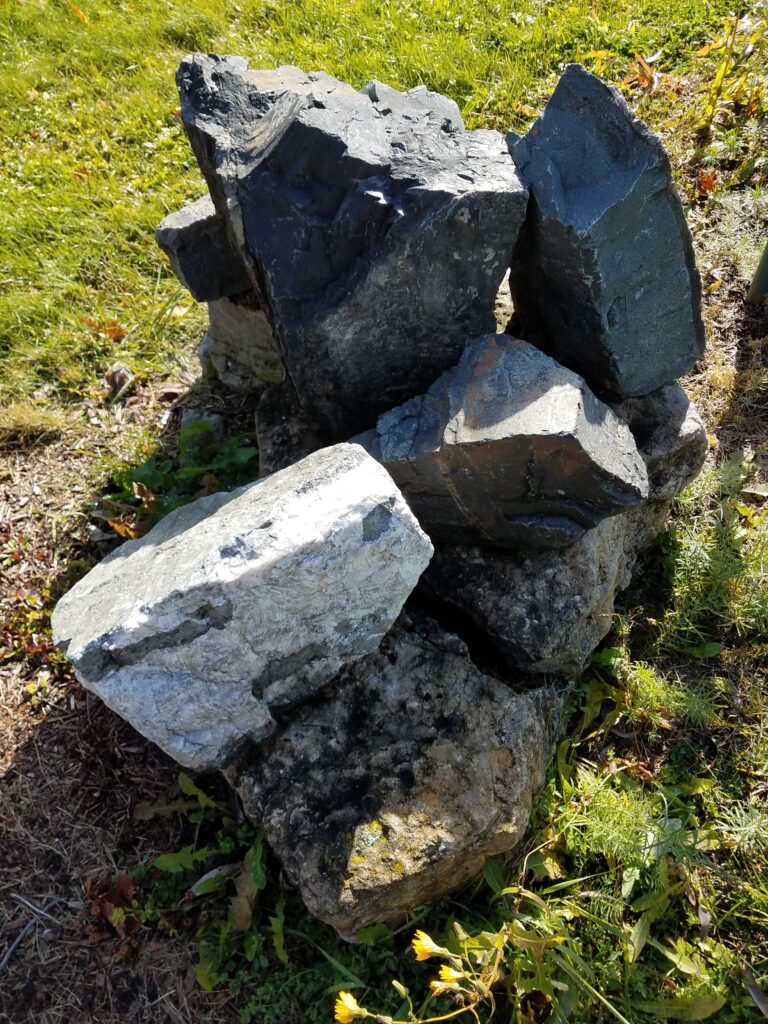
Narrow white calcite veins in Cobalt, North Cobalt, Silver Centre, Casey Mountain, etc. were the usual hosts to silver mineralisation, either in its native form or mixed with arsenides of cobalt, nickel, and iron. The host rocks were usually the Huronian Cobalt lower ‘Conglomerate’ or slatey greywacke, although silver has been found in the older volcanic ‘greenstone’ and even the Nipissing Diabase. One can test the sample for native silver by running one’s finger across the rock. If native silver is there, the sample will feel scratchy like a piece of torn metal. One might also note that silver corrodes in water and air, and, therefore, it is unlikely that one will find placer deposits of native silver like those of corrosion resistant native gold and platinum.
Internet summary of Cobalt area – seek: Cobalt Mining Legacy (2009)
MO#7A
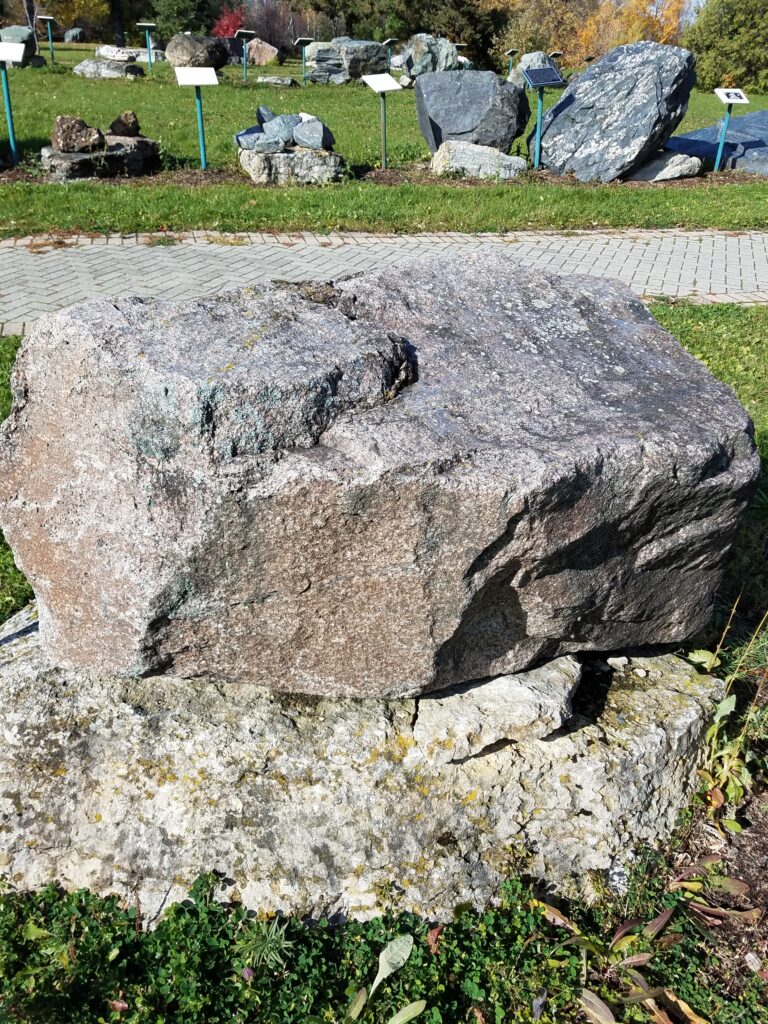
The mineral deposits of western North & South America are famous for the gigantic open pits used to mine them. Typically, they are lower grade than underground deposits, but their size allows massive production from surface operations. One of the typical mineral commodities mined in this way is molybdenum, seen here as molybdenite (or ‘moly’), a greyish-silver mineral. Usually, the ‘moly’ is found in a stockwork of narrow veinlets that criss-cross through a ‘granitic’ intrusive host rock called quartz monzonite. This sample comes from the Endako deposit (a late Jurassic granite) in central British Columbia.
View an internet teacher support system at: mineralsed.ca + Endako
MO#7B
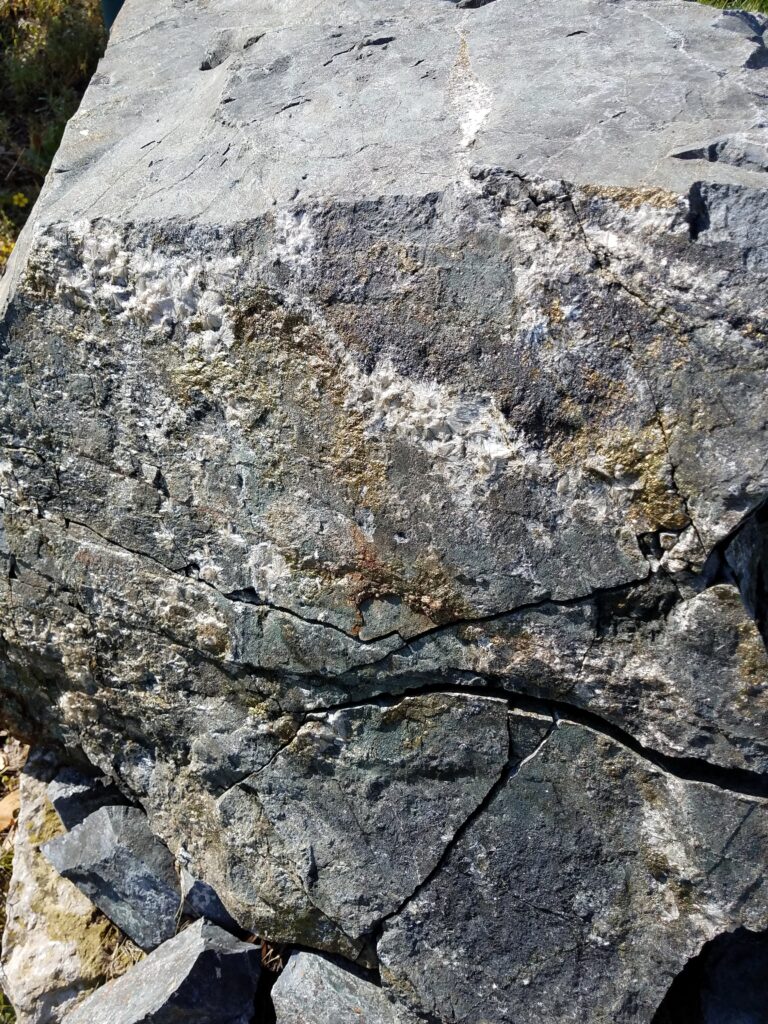
Another example of the large tonnage – low-grade type of deposit found in British Columbia is the ‘porphyry copper’ type. Jurassic volcanic rocks were intruded by Cretaceous granodiorite. Here chalcopyrite (bright yellow – copper sulphide) is disseminated throughout the quartz monzonite, this time from the Huckleberry deposit at Tahtsa Lake, B.C. Porphyry copper and stockwork ‘moly’ deposits are often found together, and there is some ‘moly’ mineralisation in this sample also.
View an internet teacher support system at: mineralsed.ca + Huckleberry
Now double back to the west side of the path. The Metallic Ore samples continue there.